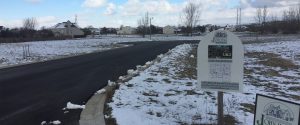Suburban subdivision development remains on hold
By Jack McCarthy Chronicle Media — December 16, 2016
A subdivision in unincorporated Kendall County has an occupied house here and there, but work on other empty lots has largely been on hold in recent years. (Photo by Jack McCarthy / Chronicle Media)
The widespread practice of converting farmland and green space into sprawling suburban subdivisions remains on hold.
The severe 2007-09 recession, accompanied by a housing market collapse, halted development dead in its tracks. And while home prices have since rebounded and interest rates are at or near historic lows, large developments featuring single family homes in distant suburbs have not reignited.
Whether it is simply a pause or whether it has permanently halted is subject of much discussion and conjecture among experts, including members of a four-person panel who discussed the status and future of suburban development through 2050 last week in Aurora.
“It hasn’t been a pause, it’s been full stop,” said Curt Paddock, director of Will County’s Land Use Department. “We haven’t approved in new subdivision in Will County in almost eight years.
“Prior to that time we were approving as many as 20 over six months of large scale housing developments. … We were approving land on a colossal basis and I think it will take 20 years to absorb it all.”
Last Tuesday’s 90-minute discussion, hosted by the Chicago Metropolitan Agency on Planning (CMAP), drew about 120 people to the Two Brother’s Roundhouse in downtown Aurora.
Like the home construction market, population growth appears to plateaued in the region.
According to CMAP, the seven-county Chicago area had a population of 9,552,031 in 2015, up by less than one percent from 2010. But in a 2014 forecast, the agency projected considerable growth to 10.6 million by 2040.
Demographics have also changed.
Today’s first-time home purchasers, part of a Millennial generation born between 1978 and 1994, will be drawn to suburbia by lower relative prices compared to the city. But they’ll also want urban-style amenities and don’t want to be totally reliant on automobiles.
The answer to some of those desires is infill, or growth that occurs in existing communities without building costly new infrastructure, according to CMAP’s “Emerging Priorities for On to 2015” planning document.
“Reinvesting in the region’s existing communities can help revitalize economically depressed areas, support new growth without building costly new infrastructure and preserve national resources,” the CMAP report stated. “Encouraging infill development is a key strategy for reinvestment and is critical for maximizing limited infrastructure dollars.”
CMAP said infill is already happening along Metra commuter rail lines as well in as historic satellite cities like Aurora, Joliet, Elgin, Waukegan and also in DuPage County.
“One of the great opportunities for suburbia is the redevelopment, the positioning of existing nodes,” said Collete English Dixon, a longtime Chicago area commercial real estate investment manager. “Looking at the millennials going forward … they want to take some of the urbanization with them so those nodes that exists — those suburban nodes that little downtowns with amenities and retail and transportation .. I think will be the appeal and I think that’s where the shift will go.
“The question is how do you find creating these somewhat urban environments in suburban spaces that are affordable to people who want to have the benefits of urbanization but can’t afford it,” she said.
But Paddock said that larger scale subdivision development model isn’t dead, so earth movers may again start moving dirt and subdivisions start rising again at some point in the future.
“In 2050 the fundamental development pattern that we have now will continue,” he said.
Aurora seemed an appropriate location for last week’s session.
Subdivision growth on the city’s edges in the 1990s and early 2000s — as well as in surrounding Kane, DuPage and Kendall counties — helped the city top 200,000 in population and emerge as Illinois’ second-largest city.
CMAP estimated that around 140,000 of the Chicago area’s agricultural and natural lands were developed between 2001-15. Counties with the most available open land — Lake, McHenry, Kane, Kendall and Will — had the most farm acreage developed.
McHenry and Kane also made significant efforts to protect other rural properties.
The CMAP session was part of the development of its “On to 2050” comprehensive plan for the region, which includes Cook, DuPage, Kane, Kendall, Lake, McHenry and Will counties.
— Suburban subdivision development remains on hold —



